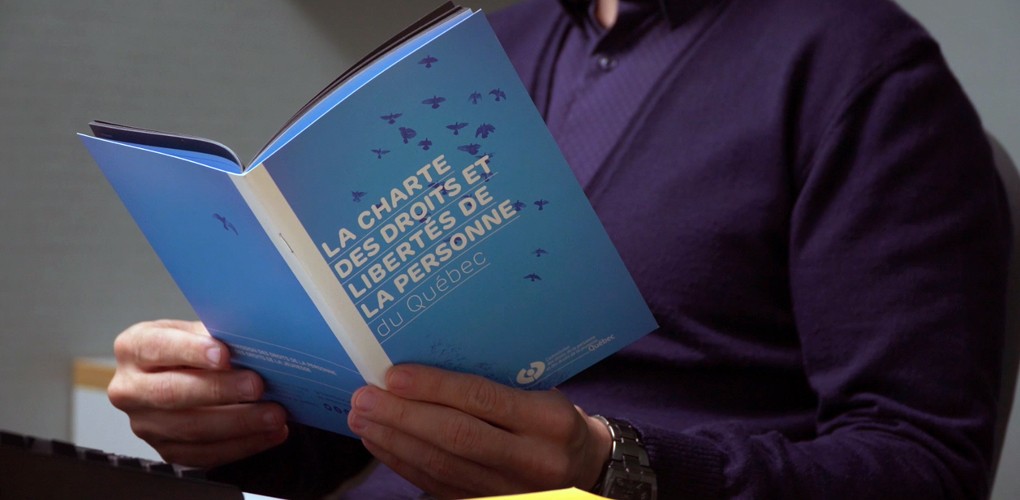Charter of Human Rights and Freedoms

The Charter is the Québec law that protects your fundamental rights and freedoms. It is a fundamental law, meaning that in most cases, all other Québec laws must comply with the Charter.
The main purpose of the Charter is to ensure consistency in the way people are treated by one another and by their institutions: it applies to relationships among individuals and to the relationship between individuals and the state.
This video presents the Quebec Charter of Human Rights and Freedoms.
The Charter of Human Rights and Freedoms protects everyone in Québec:
- adults and young people
- people who were born in Québec, other parts of Canada and abroad
- people who are visiting Québec (tourists, temporary workers)
-
Charter rights
Fundamental rights and freedoms
Such as: the right to life, to personal security, integrity, inviolability and freedom.
Right to equality
Such as: the right to non-discrimination.
Political rights
Such as: the right to vote.
Legal rights
Such as: the right to be represented by a lawyer.
Economic and social rights
Such as: the right to free public education.
The Charter prohibits certain behaviour, such as:
- exploitation of elderly people and people with a disability
- reprisals for filing a complaint with the Commission
- discriminatory questions on employment application forms
-
The origins and evolution of the Charter
The Charter has protected human rights and freedoms in Québec for more than 40 years
The Charter came into force on June 28, 1976. The National Assembly had voted unanimously to adopt the Charter a year earlier, on June 27, 1975. Fifteen years after the Quiet Revolution, the Charter launched Québec into modernity and helped create a more open and egalitarian society.
The Charter was based on international declarations and covenants that set out the rights and freedoms of all human beings, like the Universal Declaration of Human Rights, the International Covenant on Civil and Political Rights, and the International Covenant on Economic, Social and Cultural Rights.
Changes to the Charter
Since it was first passed, the Charter has been amended several times to strengthen human rights protection. For example, new prohibited grounds for discrimination have been added, including sexual orientation, disability, pregnancy, age, and gender identity and expression.
1977
Québec becomes the first province to prohibit discrimination on the basis of sexual orientation when it adds this ground to section 10 of the Charter.1979
It becomes prohibited to discriminate against a ‘handicapped person’.1979
The Charter recognizes the right of every person to conditions of employment that have proper regard for their health and safety.1982
Pregnancy and age become prohibited grounds for discrimination under the Charter.1982
“Handicapped person” is replaced with “handicap” as a prohibited ground for discrimination under the Charter.1982
The Charter is amended to prohibit discriminatory harassment.1982
It becomes prohibited to dismiss, refuse to hire or otherwise penalize someone in their employment on the basis of a previous conviction, if the conviction was in no way connected with the employment or if the person has obtained a pardon.1982
Part III is added to the Charter to oversee the development and implementation of affirmative action programs in Québec businesses and organizations.2006
The Charter recognizes that everyone has the right to live in a healthful environment in which biodiversity is preserved.2008
A clause on gender equality is added to the Charter.2016
The ground of “gender identity or expression” is added to section 10 of the Charter, which is the section that lists all the prohibited grounds for discrimination. -
Who must comply with the Charter?
- individuals
- groups and organizations
- private companies
- public and private services
- unions
- the Québec government and its institutions, and other public bodies (municipal, school), at all levels of the hierarchy
To whom does the Charter not apply?
institutions under federal authority, such as:
- the federal public service
- banks
- telecommunications companies (CBC, TVA, etc.)
- air, rail or sea transportation services (Air Canada, Via Rail, etc.)
The Canadian Human Rights Act is the law that applies to these institutions, and the Canadian Human Rights Commission is the body that intervenes in these areas.
-
Who is responsible for enforcing the Charter?
The Commission
The Commission is responsible for application of the Charter. We can intervene to uphold the right to equality of people who have experienced discrimination or harassment. We can also intervene in cases of exploitation of elderly people or people with a disability. We can receive complaints, can investigate and can represent victims defending their rights at the Human Rights Tribunal.
Learn more about the Commission
The Human Rights Tribunal
The Human Rights Tribunal (HRT) is a court that specializes in cases of discrimination, harassment and exploitation, as well as in affirmative action programs. Since it was created in 1990, the HRT has upheld the rights that are protected by the Charter.
The Charter of Human Rights and Freedoms Made Easy
This simplified and illustrated version of the Charter of Human Rights and Freedoms explains each section of the Charter in clear language and with the help of examples. The Charter Made Easy is available in:
- French (PDF, 6 Mo)
- English (PDF, 18 Mo)
- Spanish (PDF, 21 Mo)
- Arabic (PDF, 17 Mo)
- Haitian Creole (PDF, 10 Mo)
- Kanien'kéha (PDF, 7 Mo)
- Inu-aimun (PDF, 8 Mo)
- Anicinape (PDF, 10 Mo)
- Cree (PDF, 8 Mo)
- Inuktitut (PDF, 18 Mo)
- Atikamekw (PDF, 13 Mo)
The Charter Made Easy is based on the version of the Charter in force in 2015.
